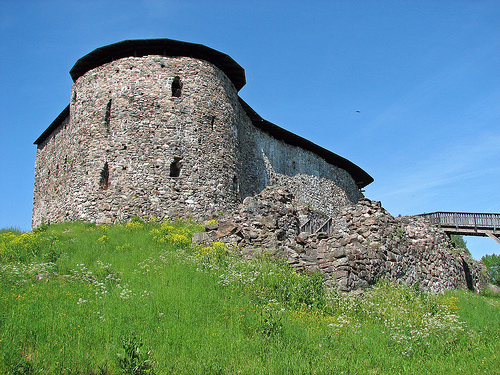

Location: Raseborg, Uusimaa Map
Constructed: 1373
Official site
Open:
May1- June 17 10am- 5pm
June
18- Aug 12 10am- 8pm
Aug 13- Aug 31, Sat, Sun in Sept 10am-
5pm
Admission Fee: adults 2 Euro
Children1 Euro
Raseborg Castle is situated near village of Snappertuna near Raseborg, Uusimaa region of Finland. The castle was constructed in 1373 on the bank of the Raseborg river by Bo Jonsson (Grip) under service of king Magnus IV of Sweden. In the medieval times a moat filled by water from the river surrounded the Raseborg citadel. It was a impressive structure against armies of the Hanseatic league armies, especially against Reval or modern Tallinn (today largest city and capital of Estonia). Raseborg Castle was a precious prize in the region. Danish, Swedish and numerous bands of pirates and bandits fought over this strategic possession. The peak of the castle came in the 15th century. It was used as a residence by the expelled king Charles VIII of Sweden (Karl Knutsson Bonde). But the walls of the stronghold also remember more gruesome scenes from the period. On the orders of the Danish king Christian II bishop Hemming Gadh was executed in 1520 on the Galgbacken (Gallows Hill) just north of the Raseborg Castle.
After Helsinki (capital of Finland) was found in the 16th century the importance of Raseborg Castle begin to subside. Eventually it was abandoned. Only in the late 18th century the restoration of the former formidable citadel began to restore military fortifications. In 1966 an open air Raseborg Summer Theatre was open. It gives performances annually in July during warmest time of the year. A major advantage of Castle over other Finish castle is that it is purely medieval. Nothing was added after the 15th century so you can enjoy history in all of its beauty.
History
Jouko Vahtola has considered that the
founding of Raseborg Castle would have been a continuation of the
German Baltic crusades and would have been founded by the successor
of Bishop Albert of Riga, his brother Bishop Hermann von Buxhövde
and his servants. The name Raseborg would thus come from the name of
the Diocese of Ratzeburg near Lübeck, Germany.
The mighty Bo
Joninpoika Grip built the first walls on the site in the 1360s and
1370s, when Johannes Westfal was the bishop of Turku. The purpose of
the flu was apparently to balance the influence of Tallinn, a lively
Hanseatic city on the other side of the Gulf of Finland. The castle
experienced its splendor in the 15th century, but after the founding
of Helsinki, the importance of Raseborg diminished until it was
abandoned in 1553. A new attempt to inhabit the castle took place
three years later. After the beer cellar collapsed a couple of years
later, the castle was abandoned again, and the abandoned castle
began to ruin. The destruction of the cellar was a great loss, as
beer was an important food in the Middle Ages.
Among other
things, King Charles Knuutinpoika owned the Raseborg Castle, where
he lived during the interim period before his third reign. In 1570,
King John III ruled the castle district in the family of his uncle
and supporter Lewenhaupt, elevating them to a county value in the
name of Raseborg, when Raseborg became a county.
Activities
today
During the summer, the castle is open to the public. The
Linnanvoudin Tupa summer café is also located in the area. Finland's
largest Swedish-language summer theater The Raseborg Summer Theater
organizes performances near the castle during the summer.
The
castle also features music videos from Babylon Whores' "Et In
Arcadia", Anna Abreu's "Stereo" and Reinforced Concrete's "Slave".
In 2017, illegal excavations were carried out in the castle
area. 284 pits were dug in the area of the castle, from which at
least dozens of medieval munitions were excavated. Raseborg Castle
and its protected areas have been pacified under the Ancient
Monuments Act. A man engaged in metal exploration was sentenced to a
term of imprisonment for a building security offense and
embezzlement.